
This week the creative practitioners answer the following question:
– What methods and approaches do you take to aid idea generation and an in-depth project outcome?
Torsten Posselt
- Ideas change over the course of a project.
- You need to come up with ways to structure to ideation.
- Prototype. Go wild!
- FAIL and ANALYSE
- Quick/fast ideas
- Mistakes help you learn
Matthew Jones and Michelle Dona
- Workshop
- Fully understand brief
- Have a core focus
- Triangulate viewpoints – yours, clients, customers
- Tailor approach to above
Wouter Dirks
- Strategic debrief
- What are the clients goals
- Brainstorm
- Early discussions with brief and strategy in mind
Stijn van de Ven
- Make lots of ideas without thinking
- Write before you design/refine
Luke Veerman
- Take it further than the client wants it
- Holistic approach
- As many ideas as possible
- Work in partnership
- Ask for feedback
Resources
David Carson TED Talk – Design and Discovery
David’s talk is all about looking at things from a different angle. He starts by showing how he looks at things on face value first – Not deciphering their deeper meaning until a later stage. Intuitive design cannot be taught and is something developed through living. It also hard to quantify it as a tangible, measurable skill. However, it is probably one of the most important aspects of design. Knowing what will work, when it will work and how it works best can be leant, but this can take time. A natural intuition not only saves time, but allows for a more exciting, unknown design process.
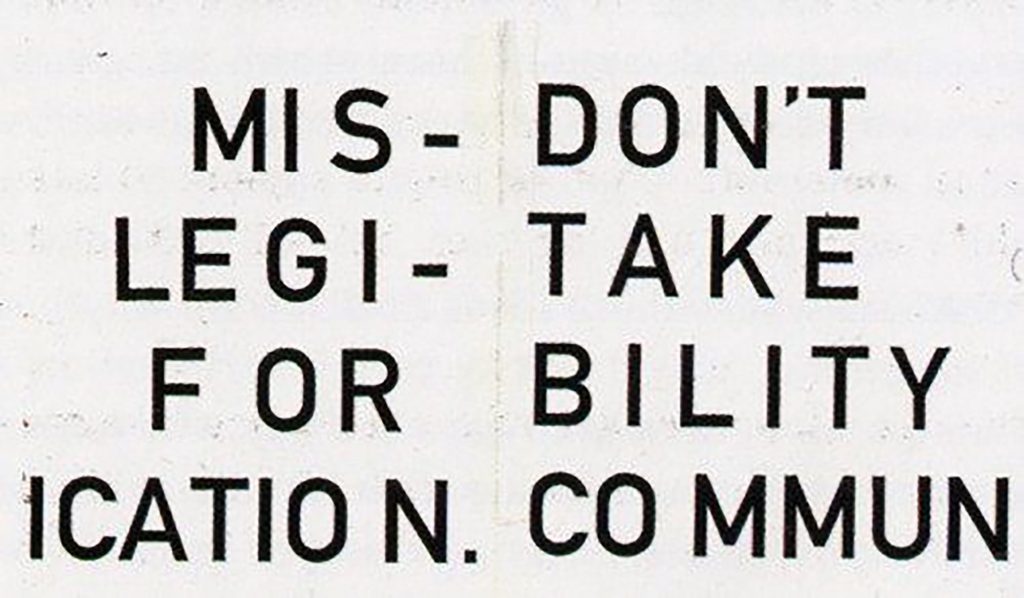
“Just because something is legible, doesn’t mean it communicates – and more importantly, doesn’t mean it communicates the right thing.” David Carson
What really strikes me about this TED talk was the humour. Carson is a funny man, and you get a sense of that through his design and this talk. He takes his warped perspective on life in general and then applies it to his work.
He goes on to say, “you have to utilise who you are in your work. No one else can do that.”
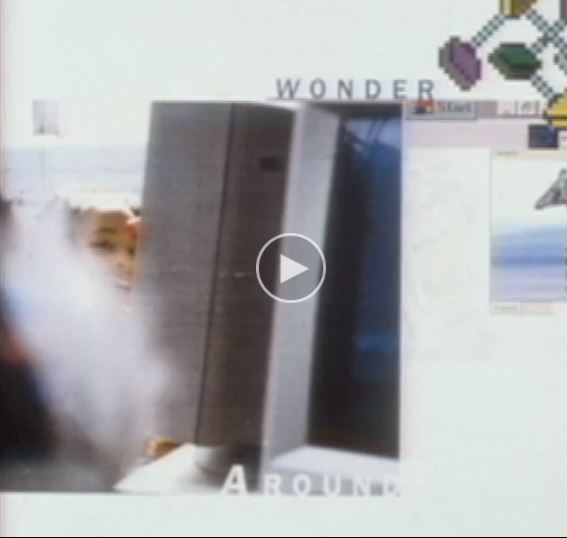
For the above advert he did for Microsoft, Carson introduced people to the campaign. This humanised the company and made the public feel a connection with them. This was interesting to me as I feel that I, so far, have overlooked the importance of people and the science museum. The digital archive is full of lots of objects. Each one of these objects also has a story and usually a person or people associated with it.
He closes with these points:
- Experiment
- Have fun
- Put yourself in the work
The Art of Looking Sideways by Alan Fletcher
Alan talks about the connections that can be made by opening your mind to other possibilities. I think a good way to describe this is to think of a word – “right” for example. It can mean “correct” but it can also mean “to turn in a direction”. This approach can be applied to areas of design. Is there more than one way of looking at something?
Inspiration is all around you and it is important to keep your eyes open to make connections between what goes on during your everyday life.

The Workshop Challenge
This week you will develop a series of initial design concepts that are in line with your project needs.
- Develop a broad selection of initial design ideas that are appropriate to your positioning (mission) statement and target audience. We encourage you to think laterally and push your ideas above and beyond the project strategy.
- Post initial design developments to your blog.
- Add your initial concepts onto the Ideas Wall to encourage peer feedback. Reflect on the feedback and summarise the comments on your blog.
- Seek advice and feedback from your target audience and key stakeholders, such as industry professionals, research groups or any relevant parties. Post feedback and comments onto the Ideas Wall and elaborate on your blog
The Crazy 8
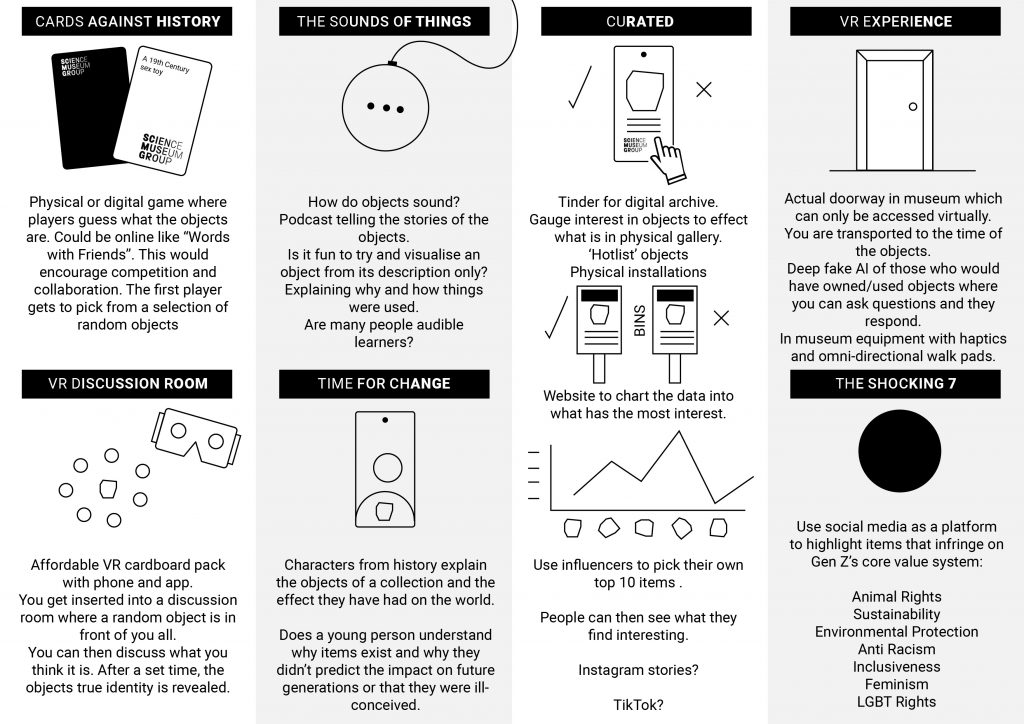
Feedback from Cohort
After posting my initial 8 ideas to the wall, I was surprised to learn about others interests in the option which made the archive accessible to others. The Science Museum prides themselves as being ‘open for all’ and this would certainly be a positive step in that direction.
“Open for All is one of the Science Museum Group’s five core values. It underpins our working practices and is embedded into everything we do. We are committed to ensuring that all people, be it our colleagues or the millions of people who visit our sites or engage with us online, see our museums and sites as places for them.
Our public programme, accessible practices, and the stories we tell through our collection all play an essential role in creating spaces that are open for everyone.”
Shiina also mentioned that audio solutions will be becoming more and more used in the future and that it is a trend to watch out for.
Ellie liked the ‘Curated’ idea for its fun element. She also like ‘the Shocking 7’. I wonder if there is a way to combine these two ideas? What I like about this idea is that it gathers meaningful data which can have a physical outcome in the form of change in the actual museum.
Wes picked up on a small joke that I had inserted about the cards focussing on things that would get people’s attention – Well….it got his! I like Wes’ ability to think outside of the box, and he suggests looking into the sound objects make from the energy within. Is this a thing? I will look into this further.
Overall, positive comments from my fellow students. They picked on some things that I would have not done so if I were working in isolation. These comments will help shape the final outcome and I hope to continue this dialogue with them going forward.
Feedback from Junior Designer – Aged 23
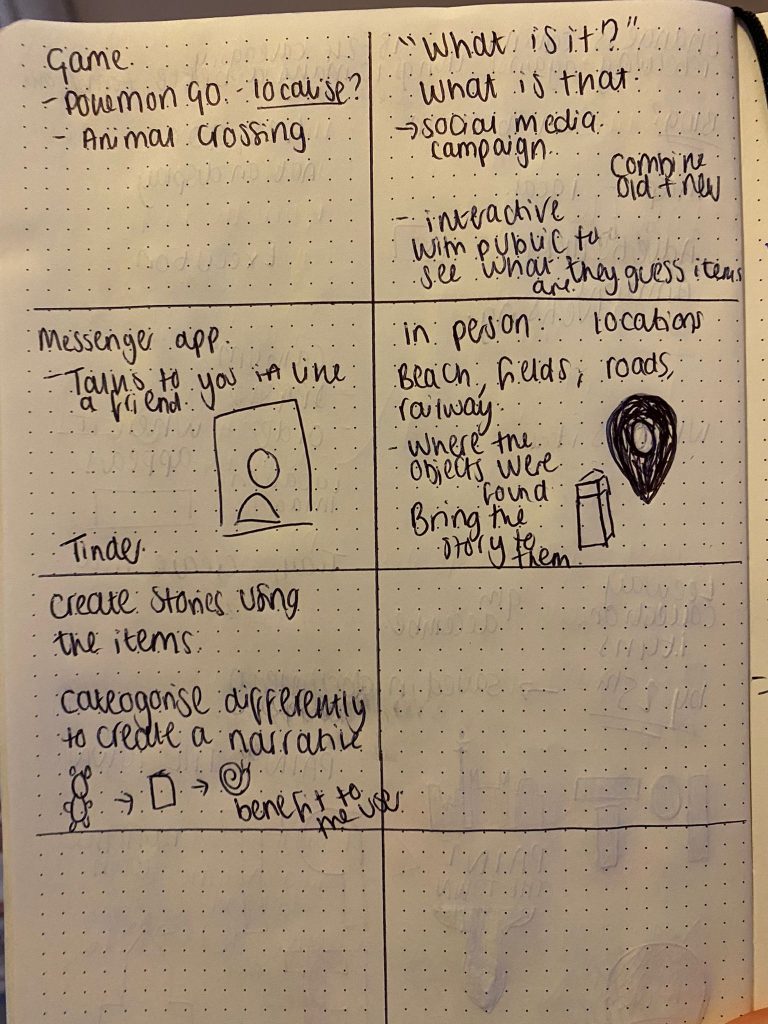
Lauren is my Junior Designer and is the correct age group for this brief. I asked her to come up with some ideas of her own to see how they differed from mine.
She too came up with a game, but many of her ideas could be used to support a bigger main idea. Social media campaigns and personal responses to messages would go a long way to humanising the museum and attracting a younger audience.
I really like the idea of taking the solution offline and installing exhibitions, or places where the public can interact with the museum, outside the museum. Not everyone can get to London etc so this may attract people from a wider geographic.
Lauren also picked up on the importance of the stories behind these objects and wondered if there was a way they could be linked by their stories.
Feedback From Another Professional
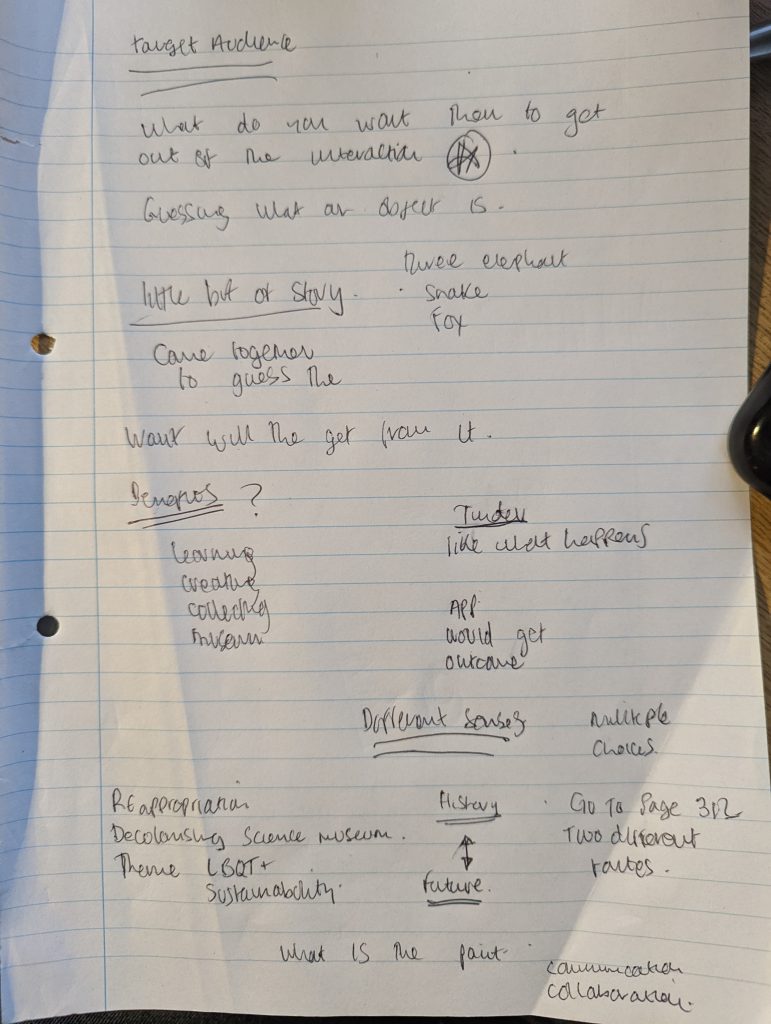
This week I arranged a tutorial with Harriet to go over my ideas and see if there were areas I could improve on. My notes from that meeting are below:
The biggest thing I got from this meeting was a rhetorical question:
“What will your audience get from this interaction?” or as Harriet eloquently put it, “what is the point?!”.
If they don’t get anything from it, they simply won’t do it. This is something I will have to ponder and something I will bring up later this week in the Crit with John Stack from the Science Museum.
It comes back to that saying from earlier about mistaking legibility for communication. What message am I trying to communicate and why?
Week 8 Crit
This week’s crit was with John Stack from the Science Museum. I wanted to use this as an opportunity to speak further about what people get out of visiting the digital archive online. But more than that, I wanted to know if things could be offered to entice a wider audience to engage with the final outcome.
My initial ideas for things that could be offered included:
- Accreditation Scheme – Certificates for different levels of engagement
- Entertainment value
- Make changes to physical gallery
- Organise an event where you only get tickets if you engage with outcome
- “Thank you”
- Personalised messages from influences etc
My notes for the Crit can be seen below:
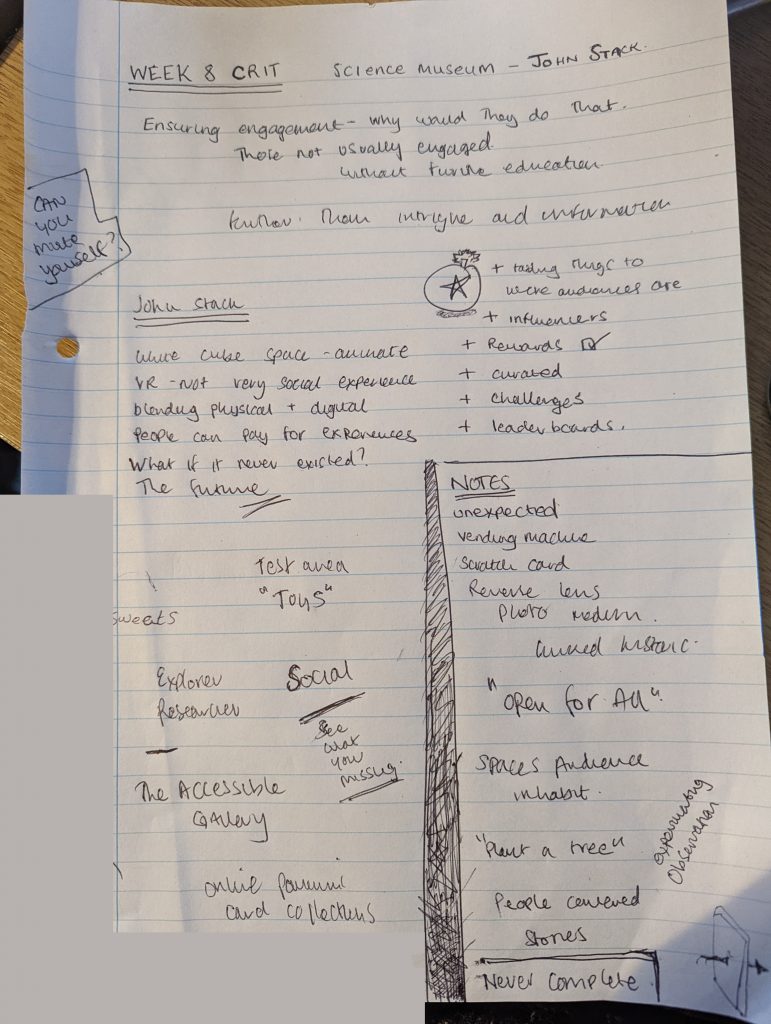
The personal notes that John gave me to my question and points that stood out included:
- Take the outcome to where your audience is
- Use influencers
- Offer rewards
- Challenges and leader boards are a good way to engage
- People will pay for experiences
- VR can be unsociable
- Blend physical and digital
- People centred stories
Through his discussions with others in the group, I picked up on the word ‘social’. John likes things that encourage socialisation, conversation, and engagement through word of mouth.
I also think that the future plays an important part in the Science Museums goals. The collection is never complete and will always be added to. I wonder if I can encourage content creation through my chosen outcome?
New Directions
From the feedback above, I think that there are two ideas that answer the brief best. I like the idea of the card game, but I also like the idea of an accessible gallery for those with additional needs. This is a great start, and I am beginning to understand both the needs of the museum and those of my target audience. By keeping them both in mind I hope to achieve an outcome that engages them equally.
References
Carson, D., 2003. Design and discovery. [online] Ted.com. Available at: <https://www.ted.com/talks/david_carson_design_and_discovery?language=en> [Accessed 10 December 2021].
Youtube.com. 2007. The Art of Looking Sideways by Alan Fletcher. [online] Available at: <https://www.youtube.com/watch?v=meKUDU0sH5w> [Accessed 10 December 2021].


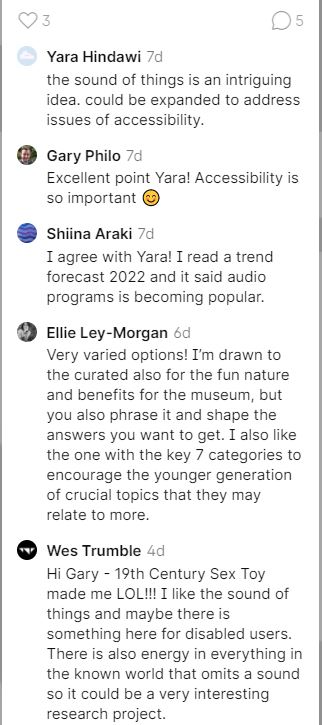
Leave a Reply